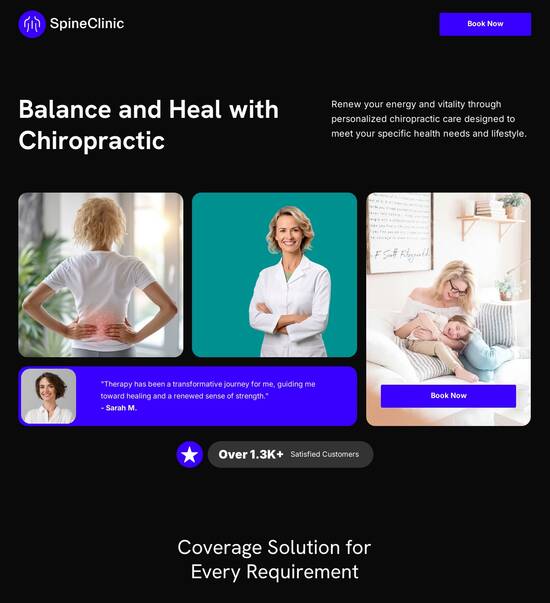
HTML/CSS optimized podcast page template
Explore Similar TemplatesAbout template
Supercharge your podcast page with HTML/CSS for outstanding performance! Learn more today.
Recommended templates

Easy to build without coding
With the intuitive drag-and-drop builder, anyone on your team can create high-converting pages without any knowledge of code or design. Make enhancements to your landing page with custom widgets using Javascript, HTML/CSS, or third-party scripts.

Multiple layouts for any industry and goal
Select from 500+ landing page layouts built to boost conversions across industry-specific scenarios. Customize them by adjusting fonts, adding images, and generating on-brand content with the AI assistant. Quickly scale with Instablocks® and Global Blocks that you can save, reuse, and update globally.

Loads fast and looks polished on any device
Every template is responsive, which means they present professionally on any device and load blazingly fast with our Thor Render Engine. You can also power them up with Google AMP technology to deliver an unparalleled mobile experience and drive higher conversions.

Robust analytics & experimentation
Get real-time updates and reporting across all your devices, showing the number of visitors, conversions, cost-per-visitor, and cost-per-lead. Launch AI-powered experiments, run A/B tests, and use heatmaps to analyze user behavior, then optimize your landing page to maximize conversions.







Easy to build without coding
With the intuitive drag-and-drop builder, anyone on your team can create high-converting pages without any knowledge of code or design. Make enhancements to your landing page with custom widgets using Javascript, HTML/CSS, or third-party scripts.
Multiple layouts for any industry and goal
Select from 500+ landing page layouts built to boost conversions across industry-specific scenarios. Customize them by adjusting fonts, adding images, and generating on-brand content with the AI assistant. Quickly scale with Instablocks® and Global Blocks that you can save, reuse, and update globally.
Loads fast and looks polished on any device
Every template is responsive, which means they present professionally on any device and load blazingly fast with our Thor Render Engine.
Robust analytics & experimentation
Get real-time updates and reporting across all your devices, showing the number of visitors, conversions, cost-per-visitor, and cost-per-lead. Launch AI-powered experiments, run A/B tests, and use heatmaps to analyze user behavior, then optimize your landing page to maximize conversions.
All the features you need to build lead-generating landing pages
Explore more featuresLearn how to build top-performing landing pages for any goal
FAQs
Leading the way in building high-performing landing pages





An effective step-by-step guide to using Instapage for landing page creation and optimization
Instapage is your go-to platform for creating high-converting landing pages that enhance your digital marketing strategies. With its rich features tailored for marketers in various sectors, you can significantly increase your campaign ROI by utilizing an easy-to-navigate interface and powerful tools. This guide provides actionable steps to harness the full potential of Instapage, making it invaluable for professionals in business services, tech, finance, and more.
Understanding the fundamentals of Instapage
Before diving into creating your landing pages, it's essential to understand the key features that make Instapage an unparalleled choice for marketing campaigns. Instapage empowers users with a suite of tools including customizable templates, lead generation elements, and advanced A/B testing capabilities. These features are designed to optimize conversion rates, personalize content, and collaborate efficiently with your team.
- 100+ high-converting templates: Quickly get started with designs that have been proven to drive leads and maximize conversion rates.
- AdMaps for alignment: Connect specific ads to tailor-made landing pages, ensuring seamless user experiences.
- Analytics and heatmaps: Gain insights into user behavior with detailed analytics tools, allowing you to make data-driven decisions.
Step 1: Building your landing page
Creating a landing page in Instapage is straightforward. Here's how you can do it efficiently:
- Choose a template: Select from over 100 templates that match your campaign's goals.
- Customize with ease: Utilize the drag-and-drop editor to modify text, images, and forms, ensuring your page reflects your brand.
- Integrate lead generation tools: Add lead capture forms that engage visitors right away, optimizing the chance for conversion.
Step 2: Optimizing for conversions
After building your landing page, optimization is key to enhancing conversions.
- Use A/B testing: Test different versions of your page to discover what resonates best with your audience.
- Implement heatmaps: Leverage heatmaps to analyze visitor engagement and adjust your layout accordingly.
- Utilize dynamic text replacement: Personalize experiences for users based on their search queries to improve relevancy.
Step 3: Analyzing performance and iterating
Post-launch analysis will help refine your strategies for future campaigns. Consistent performance reviews bolster ongoing success.
- Track essential metrics: Monitor conversion rates, visitor numbers, and interaction statistics for informed adjustments.
- Solicit feedback from stakeholders: Use Instapage's collaboration tools to gather insights from team members.
- Iterate based on results: Modify and improve your landing page based on real-time data and stakeholder feedback.
By following these steps, you can effectively utilize Instapage to maximize the performance of your digital marketing campaigns, ensuring that every initiative is poised for success.
Ready to transform your marketing campaigns? Start using Instapage today to create compelling landing pages that impress and convert visitors effortlessly!
People also ask about HTML/CSS optimized podcast page template
Creating a standout podcast page: A deep dive into an HTML/CSS optimized template
Understanding the importance of a professional podcast page
A professional podcast page serves as the digital home for your auditory content and plays a vital role in establishing brand identity. Your podcast's design directly influences how audiences perceive its value. A well-structured page that aligns with your podcast's theme encourages listeners to engage and develops a lasting connection with your brand.
Moreover, enhancing visibility and discoverability is crucial in today's saturated market. A well-optimized podcast page can significantly impact how listeners find your content. By implementing key SEO elements, you make it easier for search engines to index your content, thus increasing accessibility. Basic elements such as meta tags, keywords, and alt texts improve your page's chances of being revealed to a wider audience.
Key features of an optimized HTML/CSS podcast template
An optimized HTML/CSS podcast template should feature a structured layout that compels user engagement. Following best practices in layout design helps maintain user interest. Utilizing CSS grids and flexbox can help create a fluid and responsive design that adapts seamlessly to different devices and screen sizes. This flexibility ensures that whether a listener accesses your podcast page from a smartphone, tablet, or desktop, they will have a consistent and enjoyable experience.
Structured layout promoting easy navigation and user engagement.
CSS grids and flexbox for responsive and adaptive designs.
Customization options for branding elements like logos and colors.
Ensuring a seamless viewing and listening experience across devices
To deliver a seamless experience, implementing responsive design is essential. This can be achieved through CSS media queries, which allow you to tailor styles based on device characteristics like screen size. Testing your podcast page across mobile, tablet, and desktop environments is crucial to ensure consistency. A robust testing phase identifies usability issues, ensuring your audience enjoys a polished platform regardless of the device they use.
Furthermore, optimizing load times is another critical aspect. Keeping users waiting can lead to frustration and increased bounce rates. Techniques such as compressing images, minimizing CSS and JavaScript files, and utilizing caching can help reduce loading times significantly. A fast-loading podcast page engages users more effectively, promoting retention and encouraging them to explore your content further.
Engaging content strategies for your podcast page
Ensuring that your podcast page showcases engaging content is essential. Consider utilizing various dynamic layouts, such as sections for featured episodes, guest bios, and listener resources. Incorporating visual elements—like high-quality images, graphics, and video snippets—can significantly enhance the user experience and maintain audience interest. An aesthetically pleasing layout helps convey your podcast's tone and encourages interaction, making visitors feel welcome.
Feature sections for popular episodes to draw new listeners.
Include guest bios to build connections and credibility.
Provide show notes and transcripts for in-depth engagement.
Incorporating detailed show notes and transcripts improves both SEO and user engagement. Transcripts allow search engines to index your podcast content better, making it more discoverable. Additionally, providing transcripts caters to a broader audience, including those with hearing impairments. Show notes can summarize key points discussed during episodes and encourage social sharing, fostering a sense of community around your podcast.
Enhancing interactivity and user feedback
Creating an intuitive user interface (UI) enhances user interaction on your podcast page. Elements like buttons, links, and navigation menus should be clearly visible to prevent confusion and facilitate smooth interactions. The user experience should always be prioritized, ensuring that visitors can easily find and play episodes, access show notes, or interact with your other content.
Feedback mechanisms, such as ratings, comments, and social media sharing options, are also crucial for developing a loyal listener base. Allowing users to express their opinions fosters a sense of community and connection. Implementing forms for listener engagement, such as listener surveys or feedback forms, enables you to gain valuable insights into your audience preferences and iteratively improve your content.
Platforms for publishing and their impact on podcast page optimization
Choosing the right hosting platform is essential for your podcast's success. A variety of services provide unique features, including unlimited storage, detailed analytics, and easy integration with syndication tools. Popular options include SoundCloud, Libsyn, and Anchor, each with its own set of advantages. You need to consider your specific needs and goals before selecting a platform that fits your objectives.
Integrating an RSS feed ensures that new episodes distribute seamlessly across your platforms, allowing automatic updates. This feature can significantly enhance discoverability as you grow your listener base. Syncing with social media platforms is another effective strategy. Sharing each episode across your channels increases outreach, driving traffic back to your dedicated podcast page.
Advanced CSS techniques for customization
Finally, advanced CSS techniques can elevate your podcast page's aesthetics and functionality. Implementing CSS effects and animations helps to engage users, provided they remain subtle and not overly distracting. For instance, hover effects for buttons can enhance the interactive aspect of your page while maintaining professionalism.
Create hover effects to improve user interaction.
Utilize CSS animations to guide users through important features.
Additionally, adopting a mobile-first design approach can be particularly beneficial. This strategy involves designing your podcast page for mobile devices first before adapting it for larger screens. Such an approach prioritizes the mobile user experience, which is critical given the increasing number of users accessing content via smartphones. Employing CSS strategies such as flexible layouts and media queries ensures your design works seamlessly on various devices.
Evaluating the performance of your podcast page
To understand how well your podcast page performs, utilizing analytics tools is vital. Tools like Google Analytics can track user behavior, engagement metrics, and drop-off rates, offering valuable insights into how listeners interact with your content. This data can guide strategic decisions on enhancing user experience and optimizing podcast content.
A/B testing is another effective method for continuous improvement. By experimenting with different layouts, color schemes, and content placements, you can determine which formats resonate best with your audience. This iterative approach enables you to refine your podcast page over time, ensuring it meets listener needs and preferences.
Legal and accessibility considerations
When developing your podcast page, adhering to web accessibility standards is non-negotiable. Ensuring your page is accessible to all users, including those with disabilities, is crucial for inclusivity. Implementing techniques for compliance with standards such as the Web Content Accessibility Guidelines (WCAG) and the Americans with Disabilities Act (ADA) helps you cater to diverse audiences.
Additionally, copyright and content licensing are critical considerations as well. Understanding the importance of audio and image rights ensures that you respect intellectual property laws while providing your audience with quality content. Citing external content correctly not only protects you legally but also builds credibility within your podcast community.
Future-proofing your podcast page
Future-proofing your podcast page involves adapting to evolving trends in both podcasting and web design. Staying updated on industry changes and design best practices will help maintain your page's relevance. Utilizing tools and resources for continuous learning and adaptation ensures that your podcast evolves alongside listener expectations. Regularly updating content and design elements reflects commitment and encourages audiences to stay engaged.
Moreover, exploring integration with emerging technologies can provide your podcast page with a competitive edge. From incorporating artificial intelligence for personalized experiences to enhancements that allow for greater interactivity, being open to new advancements in web development technologies helps you remain ahead of the curve. Embracing change fosters a progressive approach, ensuring your podcast consistently meets modern demands.
Ready to skyrocket conversions?
Supercharge your ad campaigns with high-performing landing pages
Get started














